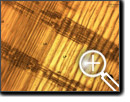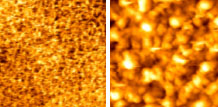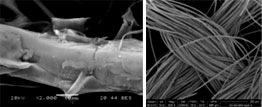» Analysis Techniques
Modern analytical instruments are of pivotal importance in order to characterise either the plasma processes or the material surface after plasma treatments, as well as the environmental impact of the formers.
The morphological surface modification after plasma treatments can be evaluated by a series of different microscopes. The techniques include optical microscopes (OM), a scansion electron microscope (SEM) able to evaluate morphological surface modification in the scale of microns, and an atomic force microscope (AFM) to investigate the surface in the scale of nanometers [1].
Recently, the laboratory was equipped with a dual ion-electron beam (FIB-SEM) in order to analyse and develop nano-scale processing of samples, and also for surface treatments (such as ion implantation, surface patterns,.) [2].
Film thickness is evaluated by means of a stylus profiler. Polymeric compounds can be chemically characterised by using two multi-probe nuclear magnetic resonance instruments (NMR) [3], one medium field (400 MHz) and one high field (500 MHz) in order to evaluate the chemical structure of polymers, and two infrared spectroscopes (FT-IR) in order to evaluate the functional groups of polymers. To calculate the molecular weight and the transition temperature of polymers a size-exclusion liquid chromatography (SE-HPLC) and a differential scansion calorimeter (DSC) are available.
Measurements of macroscopic material properties (such as adhesion, water repellence, wet-ability, surface tension,.) have been performed through the static and dynamic contact angle analysis, roll-off test.
Other macroscopic and microscopic analyses are performed at the following institutions: The Donegani Institute (ESCA), the Stazione Sperimentale per la Seta, and the Stazione Sperimentale per la Carta.
For the gas analysis, three gas-chromatographs with different detectors mass spectrometry (GC-MS), thermal conductibility (GC-TCD) and flame ionisation (GC-FID), and two liquid chromatographs equipped with diode array detector (HPLC-DAD) and with mass spectrometry detector (LC-MS), are available in order to characterise and quantify low molecular organic compounds.
These equipments support the research developed in PLASMAPROMETEO and are used to develop applied research focused to the industry.
 « OM- Optical Microscope: fir tree
« OM- Optical Microscope: fir tree
|
||||||||||||

 » Further information is available in papers published in scientific and popular reviews:
» Further information is available in papers published in scientific and popular reviews:
[1] “Atomic force microscopy investigation of cold plasma treated of poly(ethylene terephthalate) textiles”
G. Poletti, E. Orsini, C. Riccardi, A. Raffaele-Addamo, R. Barni
Surface and Interface Analysis 35, 410-412 (2003)
[2] “Focused Ion Beam (FIB) Characterization of Plasma Assisted Deposition on Polymer Films at the Nanoscale
M.Milani, C.Riccardi; D. Drobne, A.Ciardi, P.Esena, F. Tatti, S. Zanini
Scanning: The Journal of Scanning Microscopies (2005)
[3] “Radicalization of lignocellulosic fibers, related structural and morphological changes”
C. Canevali, M. Orlandi, L. Zoia, R. Scotti, E.L. Tolppa, J. Sipila , F. Agnoli, F. Morazzoni
Biomacromolecules 6, 1592-1601 (2005)






